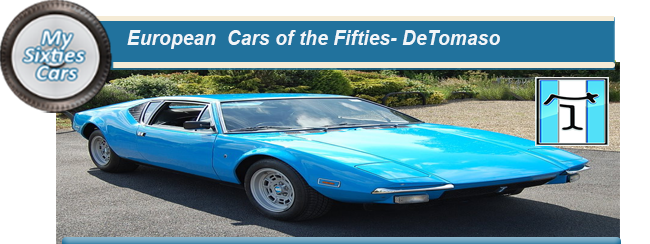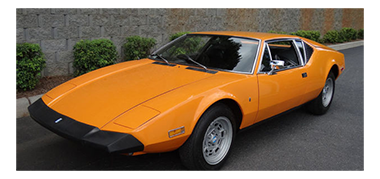 Alejandro de Tomaso, founder of the car manufacturing concern that bore his name, was as an exotic character as the cars he would go on to produce.
Alejandro de Tomaso, founder of the car manufacturing concern that bore his name, was as an exotic character as the cars he would go on to produce.
 Born into a wealthy family of cattle farmers in Buenos Aires in the late Twenties, the young Alejandro showed little interest in the family business, showing considerably more interest in racing cars.
Born into a wealthy family of cattle farmers in Buenos Aires in the late Twenties, the young Alejandro showed little interest in the family business, showing considerably more interest in racing cars.
By the time he had reached his late Twenties, political turmoil had once again begun to grip Argentina. In 1955. De Tomaso uprooted himself, not by chance to the town of Modena, the cradle of Italy's luxury sports car industry.
Word of the young Argentian's driving skills soon spread around Modena, and he was hired to become part of the OSCA racing team cars for the Maserati brothers.
De Tomaso gradually began to grasp the realisation that his motor racing days could not last forever.
In 1959 he decided to build cars in his own vision, founding De Tomaso Automobili S.p.A.

 Like so many of his counterparts of the time, his company's progress was severely hampered by a lack of working capital, with Italian banks reluctant to lend money to fledgling car manufacturers.
Like so many of his counterparts of the time, his company's progress was severely hampered by a lack of working capital, with Italian banks reluctant to lend money to fledgling car manufacturers.
De Tomaso Automobili did not allow his cash flow problems to stand in his way.
Within two years, he'd succeeded in producing half a dozen Formula 1 race cars, two of them fitted with Maserati OSCA engines.
![]()
Realising that his company could only continue their progress by building road vehicles, Alejandro began to develop a series of prototypes, culminating in the launch of the Vallelunga, powered by a four-cylinder Ford engine.
 The Vallelunga showed that De Tomaso Automobili had the capability to produce touring cars to compete with the best.
The Vallelunga showed that De Tomaso Automobili had the capability to produce touring cars to compete with the best.
The company embarked on a long cooperation with the Ford Motor Company, under the wing of legendary engineer and designer Carrol Shelby.
The pairing were responsible for the development of the Mangusta.
 The V8 engined Mangusta was designed by the Ghia design studio, with the project headed up by young and talented designer Giorgio Giugiaro.
The V8 engined Mangusta was designed by the Ghia design studio, with the project headed up by young and talented designer Giorgio Giugiaro.
By that time. De Tomaso had been appointed president of Ghia, following a significant capital injection from his parents as well as from his wife's family, wealthy U.S. industrialists.
While the Mangusta did catch a lot of positive press, sales in the U.S. were limited.
Learning some lessons, de Tomaso and Ford went back to the drawing board.
 They came up with the Pantera, which Shelby saw as a natural successor to the GT40, meaning that the vehicle would be marketed in the United States through its Lincoln-Mercury dealerships.
They came up with the Pantera, which Shelby saw as a natural successor to the GT40, meaning that the vehicle would be marketed in the United States through its Lincoln-Mercury dealerships.
Ford agreed to supply engines and help with financing.
The Pantera was released in 1971 to considerable acclaim and relative commercial success, selling around 700 models in the U.S. in the first two years.
 Race-inspired components included independent suspension, four-wheel power disc brakes, and cast magnesium wheels. The boot unit was quickly removable to allow ready access to the engine.
Race-inspired components included independent suspension, four-wheel power disc brakes, and cast magnesium wheels. The boot unit was quickly removable to allow ready access to the engine.
The Pantera was also fitted with factory air-conditioning, a major plus for a car infamous for its small and cramped cabin and the fact that it was particularly popular in warm climates.
Despite these pluses, overall, the Pantera rapidly gained a reputation for its poor reliability.
Add to that negative , the fuel shortage crisis which erupted in the aftermath of the 1973 Yom Kippur war made the vehicle a lot less appealing to even the most blinkered enthusiast.
With the attraction for the company within theFord cooperation fading rapidly, Alejandro sold his interest in the U.S. project, although retaining the Tomaso Automobili name.
 By 1974, Ford was also looking for an exit, driven by new and stricter U.S. government regulations that would have been difficult or impossible for Pantera to meet without massive structural and powertrain changes.
By 1974, Ford was also looking for an exit, driven by new and stricter U.S. government regulations that would have been difficult or impossible for Pantera to meet without massive structural and powertrain changes.
Ford recouped some of their costs by selling the production rights for the Pantera back to De Tomaso Automobili meaning that Panteras remained in limited production in the European market through the Seventies and Eighties, with over six thousand produced.
By the Eighties. Alejandro de Tomaso had succeeded in developing his company to become a key player in the European car industry, acquiring a key interest in compact car makers Innocenti and even a minority interest in Maserati, where he had begun his career in Europe as a driver twenty years previously.
Alejandro began to hand over the reins of his company to his son Santiago as ill health and advancing age took their toll, passing away in 2002 at the age of 75.

